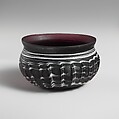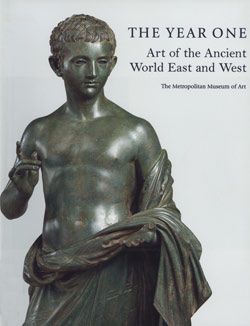Glass ribbed bowl
Translucent deep purple; trail in opaque white.
Outsplayed rim, with cracked off and ground lip; short concave neck; squat, globular body curving in to flat, thick bottom.
Trail applied as a spiral on bottom, then wound up side, ending on neck as a band of fine, irregular horizontal lines; side tooled into twenty-four slender, vertical ribs.
Intact, except for one small chip on outer edge of rim; some large and pinprick bubbles; dulling, some pitting, and faint iridescence, with weathering of trail between ribs.
Ribbed bowls like these, often decorated with opaque white trails, were very popular throughout the Roman world and may be seen as successors to the cast ribbed bowls of the first century B.C. to the early first century A.D. A major center of production was probably located in Northern Italy or the province of Pannonia along the main route to the Danube frontier.
This image cannot be enlarged, viewed at full screen, or downloaded.


